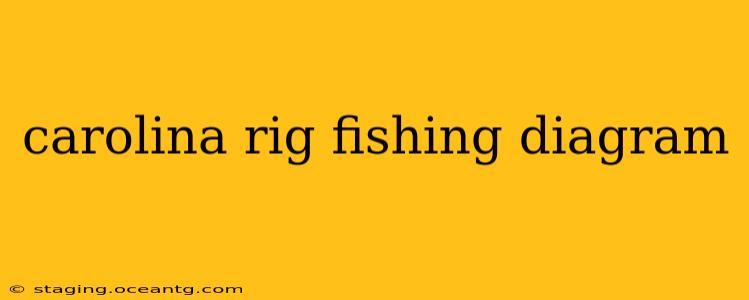The Carolina rig is a versatile fishing technique prized for its effectiveness in covering water and enticing bites from a wide range of fish species. This rig excels in targeting bass, but also works well for catfish, stripers, and other bottom-feeding fish. Understanding its components and how they work together is key to mastering this technique. This guide provides a detailed Carolina rig fishing diagram and answers common questions.
What is a Carolina Rig?
The Carolina rig is a weighted, sliding-sinker rig designed for fishing in deeper waters or areas with significant cover. Its key feature is a weight that slides freely on the line, allowing the bait to move naturally and subtly, triggering strikes from even wary fish. This free-sliding weight minimizes snags on the bottom, making it ideal for fishing around rocks, wood, or other structure.
Carolina Rig Fishing Diagram: A Visual Guide
While a picture is worth a thousand words, let's break down the components:
-
Main Line: This is your fishing line, usually monofilament or fluorocarbon of 12-20 lb test depending on the target species and conditions.
-
Weight: A bullet weight (most common), egg weight, or other sliding weight is used. The weight size depends on water depth and current conditions, ranging from 1/4 oz to 2 oz.
-
Swivel: A swivel connects the main line to the weight, preventing line twist caused by the weight's movement.
-
Leader: A length of fluorocarbon leader (typically 18-24 inches) is tied to the swivel. Fluorocarbon is preferred for its low visibility to fish.
-
Hook: A variety of hooks can be used, including offset worm hooks, Texas-style hooks, or jig heads, depending on the type of bait being used. Size will vary based on bait and target fish.
-
Bait: The bait is attached to the hook. This can be a variety of soft plastics, such as worms, lizards, or crawfish.
(Imagine a diagram here showcasing all the components visually)
How to Tie a Carolina Rig
Tying a Carolina Rig is relatively straightforward. Numerous tutorials are available online with visual guides, making it easy to learn. A strong knot is crucial, ensuring the rig holds under pressure. The Palomar knot or improved clinch knot are popular choices for connecting the line to the swivel and leader.
What are the Advantages of Using a Carolina Rig?
- Weedless: The sliding weight helps prevent snags in heavy cover.
- Long Casting Distance: The weight allows for long casts, covering more water.
- Versatile Bait Choices: You can use various soft plastic baits with this rig.
- Effective in Deep Water: Ideal for fishing in deeper areas or areas with structure.
What are the Disadvantages of Using a Carolina Rig?
- Can be Less Sensitive: The sliding weight can sometimes dampen the feeling of a bite, requiring a more careful approach.
- Requires Practice: Mastery takes time and practice to perfect the casting and hook setting.
What Weight Should I Use for a Carolina Rig?
The weight of the sinker used for a Carolina rig will largely depend on the water depth, the current strength, and the type of bottom you are fishing. In calmer waters with moderate depths, a lighter weight of 1/4 oz to 3/8 oz will be more than sufficient. For deeper waters and stronger currents, heavier weights (1 oz to 2 oz) may be necessary to keep the bait close to the bottom.
What Type of Line is Best for Carolina Rigging?
While you can use monofilament line, fluorocarbon is a better option for Carolina rigging. Fluorocarbon is less visible underwater, making it an excellent choice for clear water or wary fish. Its lower visibility increases the chance of a strike.
What are Some Good Baits for Carolina Rigs?
Soft plastic baits such as worms, lizards, and craws are excellent choices for Carolina rigs. Experimenting with different colors and sizes will help you find what works best in your fishing location. Consider using scents or attractants to further enhance your chances of success.
Conclusion
The Carolina rig is a highly effective fishing technique that anglers of all skill levels can master. Understanding its components, the benefits and drawbacks, and experimenting with different variations, allows you to refine your technique and improve your fishing results. By understanding this detailed Carolina rig fishing diagram and implementing the information above, you'll be well on your way to catching more fish!
